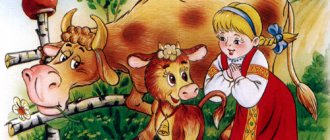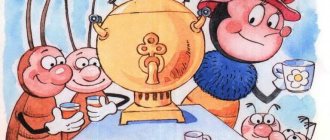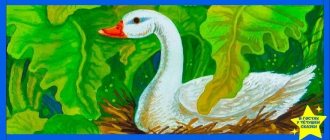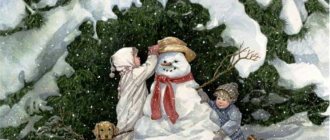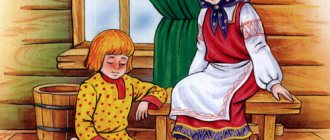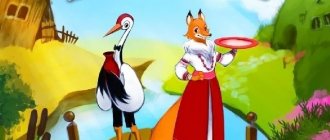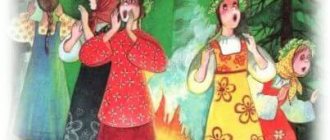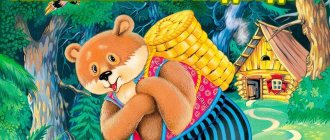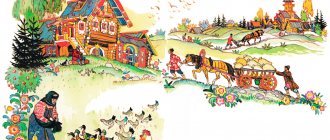The Russian folk tale Kolobok is one of the very first fairy tales in the life of every child. Kolobok was and remains the most famous fairy tale for children. On our website, parents will not only be able to read a fairy tale about Kolobok to their child, but also little listeners can listen to this story via audio, or even watch it on video. Colorful illustrations will make reading the fairy tale even more interesting and exciting.
Read the fairy tale Kolobok with pictures
Once upon a time there lived an old man and an old woman.
So the old man asks: “Bake me, old man, a bun.” - What should I bake it from? There is no flour. - Eh, old woman. Mark the barn, scratch the bottom of the tree, and you'll get it. The old woman did just that: she swept, scraped together two handfuls of flour, kneaded the dough with sour cream, rolled it into a bun, fried it in oil and laid it on the window to dry.
The bun got tired of lying - he rolled from the window to the bench, from the bench to the floor - and to the door, jumping over the threshold, into the entryway, from the entryway to the porch, from the porch to the yard, and then beyond the gate, further and further.
The bun is rolling along the road, and a hare meets it:
- Kolobok, Kolobok! I will eat you! - No, don’t eat me, scythe, but rather listen to what song I’ll sing for you. The hare raised his ears, and the bun began to sing: “I am a bun, a bun, swept across the barn, scraped along the knots, mixed with sour cream, planted in the oven, chilled at the window.” I left my grandfather, I left my grandmother, It’s not smart to leave you, hare. And the bun rolled on - only the hare saw it. A bun rolls along a path in the forest, and a gray wolf meets him:
- Kolobok, Kolobok! I will eat you! “Don’t eat me, gray wolf: I’ll sing you a song.” And the bun began to sing: “I am a bun, a bun, swept across the barn, scraped along the knots, mixed with sour cream, planted in the oven, chilled at the window.” I left my grandfather, I left my grandmother, I left the hare, It’s not smart to leave you, the wolf. And the bun rolled on - only the wolf saw it. The bun is rolling through the forest, and a bear comes towards it, breaking brushwood, bending bushes to the ground.
- Kolobok, Kolobok, I will eat you! - Well, where can you, clubfoot, eat me! Better listen to my song. The gingerbread man began to sing, and Misha's ears went wild: “I am a gingerbread man, a gingerbread man, swept across the barn, scraped through the knots, mixed with sour cream, planted in the oven, chilled at the window.” I left my grandfather, I left my grandmother, I left the hare, I left the wolf, It took me half a long time to leave you, bear. And the bun rolled - the bear just looked after it. The bun rolls, and a fox meets it:
- Hello, bun! How handsome and rosy you are! The gingerbread man is glad that he was praised, and began to sing his song, and the fox listens and creeps closer and closer: “I am a gingerbread man, a gingerbread man, swept across the barn, scraped along the knots, mixed with sour cream, planted in the stove, chilled at the window.” I left my grandfather, I left my grandmother, I left the hare, I left the wolf, I left the bear, It’s not smart to leave you, fox. - Nice song! - said the fox. “The trouble is, my dear, that I’ve become old—I can’t hear well.” Sit on my face and sing it one more time. Kolobok was delighted that his song was praised, jumped on the fox’s face and sang: “I am a Kolobok, a Kolobok... And his fox is a racket!” - and ate it.
Russian fairy tale
Children's fairy tale "Kolobok" about the eternal wheel of life
A child learns the Russian folk tale “Kolobok” even before he begins to learn to read. Parents use a children's book to tell their child about animals that may be encountered along the way if he suddenly decides to run away from home. The fairy tale is especially memorable when the grandmother reads it with expression at night; the impressions of the adventures of the main characters remain in the child’s memory for many, many years. As children grow up and learn about the changing seasons, the deep meaning of the old fairy tale can be explained to them. In kindergarten or school, teachers will be able to convey to the children what the people who came up with this funny and interesting story wanted to tell. In children's literature of different nations there are fairy tales similar to Kolobok. For example, among the British it is Johnny Donut, among the Irish it is Fat Flatbread, Pancake among the Scandinavians and the Gingerbread Man among the Germans. Why is this character found in books for children from completely different nations and who are the Hare, Wolf, Bear and Fox? To answer this question, let's take a closer look at them: Kolobok is the main character of an old fairy tale. This is unleavened bread baked from flour, butter and milk. The word “kolobok” is found in Greek and means wheat bread. The people who came up with the fascinating story imagined the red sun in the form of a Kolobok. A hot ball rolls across the sky all year round and gives all living things light, warmth and the joy of being. The hare is the first character that Kolobok met. It denotes winter, which begins every year. The wolf is the second character from whom Kolobok ran away. It represents spring, when the snow is melting, but nature is still gray and cold. The bear is the third character who wanted to eat the ruddy Kolobok. This is summer, generous and rich in food supplies. The Fox is the fourth character who managed to deceive and eat Kolobochka. She personifies the red autumn, when it is time to gather rich harvests, put them in barns and then feast on the reserves during the cold winter season. Grandfather and grandmother are the ancestors of all humanity, they love the warm sun very much and do not want it to run away. Kolobok is the hot sun that accompanies the change of seasons. The protagonist's journey means the eternal cycle of nature, and the old man and the old woman will bake Kolobok again and again so that life on Earth never ends.
Story with illustrations for family reading
A fairy tale with meaning will definitely appeal to all readers who look at the page. And photographs of bright nesting dolls, pictures and drawings will add liveliness to children's perception. Through unusual illustrations, children will get acquainted not only with the main characters of the fairy tale, but also learn about skilled craftsmen from the villages of Fedoskino, Mstera and Kholui. Large font text will help you quickly read the fairy tale and expand your vocabulary with the richness of your native Russian language. After reading, it is advisable to consolidate the impression and watch a fascinating hand-drawn cartoon or listen to a beautiful melodic audio fairy tale .
Lesson for children 2-3 years old “Kolobok”
Lesson for children 2-3 years old based on the fairy tale “Kolobok” - 1st junior group
Target
: developing children's interest and love for Russian folk tales.
Tasks:
Speech development –
— promoting the development of monologue and dialogic speech;
— enrichment of the vocabulary: figurative expressions, comparisons,
Social development –
- formation of positive relationships between children in the process
joint activities;
- development of emotions;
Cognitive development –
- development of diverse ideas about reality (different types of theater);
- memory development, learning the ability to plan your actions to achieve results.
Aesthetic development –
- introduction to highly artistic literature;
- development of imagination;
— creation of an expressive artistic image;
Development of movements –
— coordination of actions and accompanying speech;
Characters (
tabletop plane theater): woman, grandfather, fox, hare, wolf, bear, bun.
Scenery
: House, masks-caps of fairy tale characters, table and chairs, table theater.
Participants:
teacher and children
Progress of the lesson:
Children go into the hall and sit on chairs.
Greeting "Our smart heads"
Our smart heads will think a lot, cleverly. The ears will listen, the mouth will speak clearly. Hands will clap, Feet will stomp. Our backs straighten, we smile at each other.
Educator: Guys, look what’s on our table?
Children: theater!
Educator: Let's see what fairy tale heroes are waiting for us here? (we take each character in turn and examine them) Look who it is?
Children: Bunny
Educator: What do we call the bunny?
Children: bunny, run around
Educator: What kind of ears does the bunny have? How does a bunny jump? (children show) Who is this?
Children: Wolf
Educator: What do we call a wolf?
Children: top - gray barrel
Educator: show me how a wolf clicks his teeth! Well done! And who is this?
Children: Bear
Educator: What do you and I call the bear?
Children: Teddy bear
Educator: what does the bear collect?
Children: cones
The teacher scatters a basket of cones to the music; the children collect the cones. Who else do we have?
Children: fox-sister
Educator: How does a fox wag its tail? (show). Well done! Who is this?
Children: bun!
Educator: correct! What fairy tale is our guest?
Children: bun.
Educator:
Finger gymnastics “Quickly knead the dough”
Quickly knead the dough, open and close your palms. Divided into pieces, imitate pinching. Roll out all the pieces, three palms against each other. And they made little bells. We show two cams.
Educator: Now let’s play a fairy tale, shall we? Disassemble caps and masks. Take your seats. Attention! Attention! The fairy tale begins.
Educator: Once upon a time there lived an old man and an old woman (the grandfather and woman come out to the table and sit down on the chairs). So the old man asks. Grandfather: Bake me a bun Grandma: What can I bake it for you from? There is no flour! Grandfather: And you mark the barn, scrape the bottom of the tree - and you’ll get flour (shows with hands) Educator: The old woman did just that: she swept it, scraped two handfuls of flour, kneaded the dough, rolled it into a bun, baked it and put it on the window to cool (the old woman shows the actions hands)
- Kolobok got tired of lying, he jumped from the window and rolled along the path. Kolobok is rolling, and a hare is coming towards him. Hare: Kolobok, Kolobok! I will eat you!
Kolobok: Don’t eat me, I’ll sing you a song!
I am a bun, a bun, in the barn meshon
Scratching the bottom of the barrel
I left my grandmother and left my grandfather
And I’ll even run away from you, bunny!
Educator: And Kolobok rolled further, and a wolf met him: Wolf: Kolobok, Kolobok! I will eat you! Kolobok: Don't eat me! I'll sing you a song......
Educator: Kolobok rolls further, and a bear meets him: Bear: Kolobok, Kolobok! I will eat you! Kolobok: Don't eat me! I'll sing you a song......
Educator: The bun rolls further, and a fox meets it: Fox: Hello, Kolobok! How delicious you are! Educator: The cunning cheat of our bun wants to eat. Do you want a fox to make friends with forest animals? Join us in a round dance, sing and dance. Let's be friends? Lisa: Come on, I agree. Round dance with kolobok
Children stand in a circle, holding hands. The kolobok performs different movements to the lyrics of the song. I am a bun, a bun (everyone walks in a circle) I left my grandmother (do exercises as instructed by the teacher) I left my grandfather (squat) I left the bunny (jumping like a hare) I left the wolf (turns around myself) I left the bear (turns on a concave mortar) And you and I, the fox, we will dance in a circle (the fox and the bun are circling like a boat, the children clap their hands).
Educator: Oh, what great fellows! Guys, tell me, what fairy tale did we play? Children: Fairy tale "Kolobok". Educator: What animals did you meet in the fairy tale? Children: Hare, wolf, bear and fox.
Educator: I liked you all today and I want to treat you to candy! Did you like it?
Children: Yes!
Thank you for your attention!
Farewell "Rattle"
Rattle, rattle, musical toy, take it in your hand and rattle, rattle, rattle! Hide the rattle behind your back to give your ears a rest from the noise. Look at your neighbors and sit quietly. Look at your neighbors and go home.

